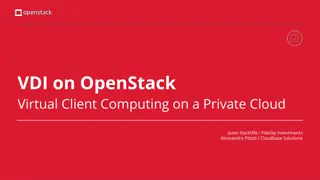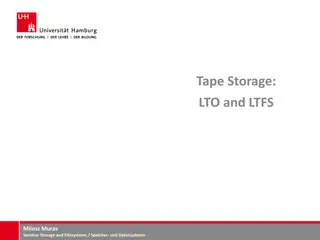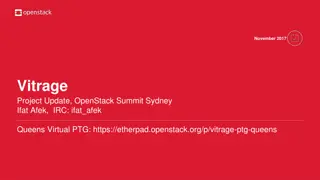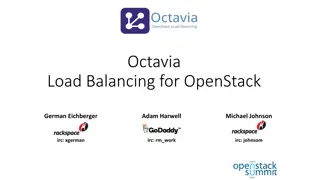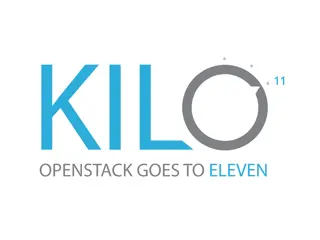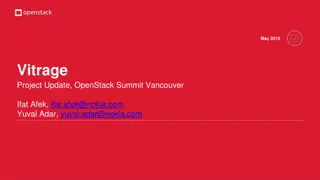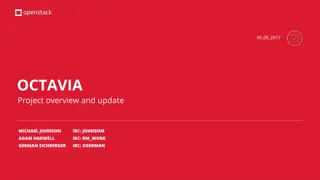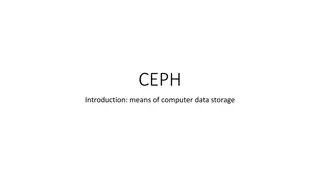OpenStack Cinder Storage Capabilities Overview
OpenStack Cinder provides persistent block storage resources for cloud environments with support for multiple back-ends and over 100 volume drivers. This overview covers key features like volume migration, volume retype, generic volume cache, replication, volume groups, backup, and restore. Additionally, it includes details on image volume caching and relevant configurations and commands.
Download Presentation

Please find below an Image/Link to download the presentation.
The content on the website is provided AS IS for your information and personal use only. It may not be sold, licensed, or shared on other websites without obtaining consent from the author. Download presentation by click this link. If you encounter any issues during the download, it is possible that the publisher has removed the file from their server.
E N D
Presentation Transcript
Storage Capabilities in Cinder Xing Yang (Dell EMC), Jay Bryant (Lenovo), Sean McGinnis (Huawei) May 9, 2017 Boston
Cinder Overview Provides persistent block storage resources for an OpenStack cloud. Supports multiple back- ends. More than 100 volume drivers in tree. 3
Agenda Volume migration and retype Generic image volume cache Replication V2.1 Generic volume groups Backup and restore 4
Volume Migration and Retype Volume migration Migration between two back-ends with the same volume type, regardless if they are located on the same Cinder volume node or not. Volume retype Migration between two back-ends with different volume types, regardless if the back-ends are located on the same Cinder volume node or not. 5
Volume Migration and Retype - commands Volume migration cinder migrate [--force-host-copy [<True|False>]] [--lock-volume [<True|False>]] <volume> <host> Volume retype cinder retype [--migration-policy <never|on-demand>] <volume> <volume-type> 6
Image Volume Cache Problem: Create boot volume very slow Solution: Image volume cache Create volume cache when image downloaded Create boot volume will clone volume instead of copying image. 7
Image Volume Cache - configs and cmds Configure the internal tenant cinder_internal_tenant_project_id cinder_internal_tenant_user_id Configure the Image-Volume cache image_volume_cache_enabled = True image_volume_cache_max_size_gb = SIZE_GB image_volume_cache_max_count = MAX_COUNT Create a boot volume and launch a VM from it in two commands openstack volume create --image IMAGE_ID --size SIZE_IN_GB bootable_volume openstack server create --flavor 2 --volume VOLUME_ID --block-device source=volume,id=$VOLUME_ID,dest=volume,size=10,shutdown=preserve,bootindex=0 myInstanceFromVolume Create a boot volume and launch a VM from it in one command openstack server create --flavor FLAVOR --block-device source=SOURCE,id=ID,dest=DEST,size=SIZE,shutdown=PRESERVE,bootindex=INDEX NAME 8
Volume-Backed Image Configure the volume-backed image glance-api.conf stores = file, http, swift, cinder show_multiple_locations = True cinder_store_auth_address cinder_store_user_name cinder_store_password cinder_store_project_name cinder.conf glance_api_version = 2 allowed_direct_url_schemes = cinder image_upload_use_cinder_backend = True image_upload_use_internal_tenant = True Create a volume-backed image openstack image create --volume SOURCE_VOLUME IMAGE_NAME The disk format and the container format must be raw and bare (default). Otherwise, the image is uploaded to the default store of the Image service. 9
Replication V2.1 Replication API v2.1 (Cheesecake): fail over the whole backend when disaster strikes (Admin API). 10
Replication V2.1 - configuration Configuration in cinder.conf under the driver section and through the use of volume types Specify replication_device (backend_id) in cinder.conf Volume type extra specs { replication_enabled : <is> True } Capabilities reporting stats["replication_enabled"] = True|False stats["replication_targets"] = [<backend-id_1, <backend- id_2>...] 11
Replication V2.1 - commands Failover host cinder failover-host [--backend_id <backend-id>] <hostname> Freeze host cinder freeze-host <hostname> Thaw host cinder thaw-host <hostname> 12
Generic Volume Groups A grouping construct that allows volumes used in the same application to be managed together. https://blueprints.launchpad.net/cinder/+spec/gene ric-volume-group https://github.com/openstack/cinder/blob/master/d oc/source/devref/groups.rst https://docs.openstack.org/admin- guide/blockstorage-groups.html May or may not support consistent group snapshot depending on driver implementation and group types. 13
Generic Volume Groups - group types Group types and group specs are introduced to describe the characteristics of a group, similar to how volume types and extra specs are applied to a volume. Minimum microversion: 3.11 cinder --os-volume-api-version 3.11 group-type-create my_test_group cinder --os-volume-api-version 3.11 group-type-list cinder --os-volume-api-version 3.11 group-type-show my_test_group cinder --os-volume-api-version 3.11 group-type-key my_test_group set test_key=test_val cinder --os-volume-api-version 3.11 group-specs-list cinder --os-volume-api-version 3.11 group-type-key my_test_group unset test_key cinder --os-volume-api-version 3.11 group-type-update <group type uuid> --name "new_group" -- description "my group type" cinder --os-volume-api-version 3.11 group-type-delete new_group 14
Generic Volume Groups - groups Create, delete, update, show, and list groups Minimum microversion: 3.13 cinder --os-volume-api-version 3.13 group-create --name my_group <group type uuid> <volume type uuid> cinder --os-volume-api-version 3.13 group-list cinder --os-volume-api-version 3.13 create --group-id <group uuid> --volume-type <volume type uuid> <size> cinder --os-volume-api-version 3.13 group-update <group uuid> --name new_name description new_description --add-volumes <uuid of volume to add> --remove- volumes <uuid of volume to remove> cinder --os-volume-api-version 3.13 group-show <group uuid> cinder --os-volume-api-version 3.13 group-delete --delete-volumes <group uuid> 15
Generic Volume Groups - group snapshots Create, delete, show, and list group snapshots. Minimum microversion: 3.14 cinder --os-volume-api-version 3.14 group-snapshot-create --name <name> <group uuid> cinder --os-volume-api-version 3.14 group-snapshot-list cinder --os-volume-api-version 3.14 group-snapshot-show <group snapshot uuid> cinder --os-volume-api-version 3.14 group-snapshot-delete <group snapshot uuid> Create group from source group or group snapshot. cinder --os-volume-api-version 3.14 group-create-from-src --name my_group --group- snapshot <group snapshot uuid> cinder --os-volume-api-version 3.14 group-create-from-src --name my_group --source- group <source group uuid> 16
Migrate CGs to Generic Volume Groups Command cinder-manage db online_data_migrations needs to be run to migrate existing consistency groups to generic volume groups. It is required to run data migrations to upgrade to Pike. All drivers supporting CGs need to add this capability to generic volume groups in Pike. CG APIs still work in Pike but will be deprecated in Queens. 17
Create Different Types of Groups Set the following in group type specs and volume type extra specs when creating a generic volume group that supports consistent group snapshot on a backend that reports consistent_group_snapshot_enabled=True : consistent_group_snapshot_enabled: <is> True If { consistent_group_snapshot_enabled: <is> True } is not set in the group type, a default group will be created that does not support consistent group snapshot. Do not set consistencygroup_support key in group types or volume types 18
Backup and Restore Supports full and incremental backup using changed block tracking (sha file). Supports non-disruptive backup for in-use volumes via temp volume/snapshot. Supports backup of snapshot. Supports Swift, Posix, NFS, GlusterFS, Ceph, Google Cloud Storage, and IBM TSM backup drivers. 19
Cinder backup - commands Create a backup (full, incremental, in-use) openstack volume backup create [--incremental] [--force] VOLUME Restore a backup openstack volume backup restore BACKUP_ID VOLUME_ID Create a backup from a snapshot openstack volume backup create [--incremental] [--force] [--snapshot SNAPSHOT_ID] VOLUME Export metadata of a backup (admin only) cinder backup-export BACKUP_ID Import backup metadata (admin only) cinder backup-import METADATA 20
Demos Volume migration and retype Generic volume groups Backup and restore 21
Demo Volume Migration and Retype Environment Two LVM backends One NFS backend Volume Types One for each backend One for iSCSI protocol Demo lvmdriver-1 retype to iSCSI type lvmdriver-1 migrate to lvmdriver-2 lvmdriver-2 retype with migrate to nfs Controller lvmdriver-1 NAS lvmdriver-2 nfs-1 22
Demo Generic Volume Groups Demo setup: 2 Cinder volume backends Unity 500 VNX7600 Cinder.conf 24
Demo Backup and Restore Demo setup: Cinder-backup configured for Swift target Database server instance with data on Cinder volume 26
Reference Links Volume migration and retype https://github.com/openstack/cinder/blob/master/doc/source/devref/migration.rst Generic volume image cache https://docs.openstack.org/admin-guide/blockstorage-image-volume-cache.html Volume backed image https://docs.openstack.org/admin-guide/blockstorage-volume-backed-image.html Backup and restore https://docs.openstack.org/admin-guide/blockstorage-volume-backups.html Replication V2.1 https://github.com/openstack/cinder/blob/master/doc/source/devref/replication.rst Generic volume groups https://docs.openstack.org/admin-guide/blockstorage-groups.html 28



